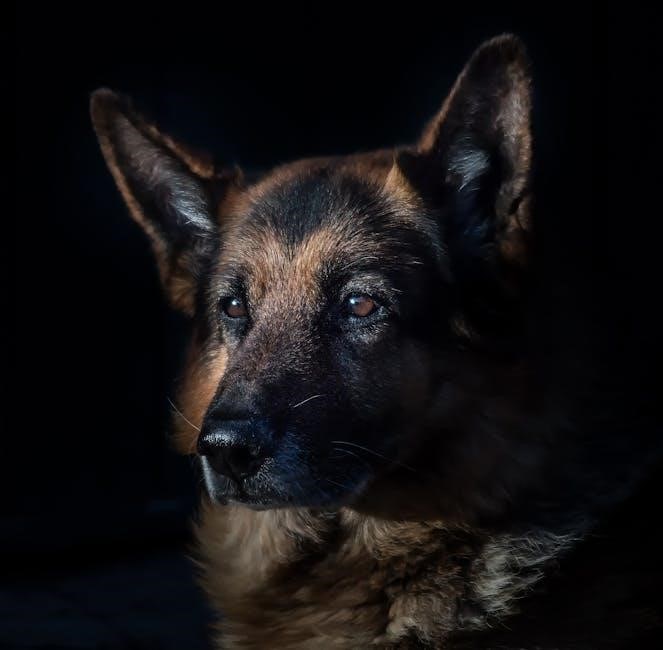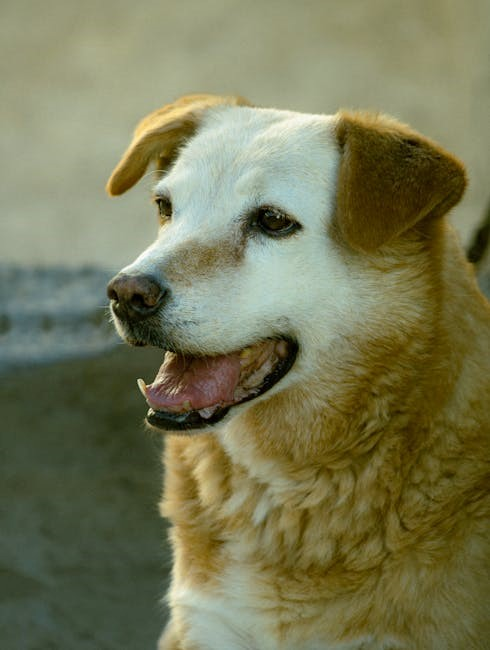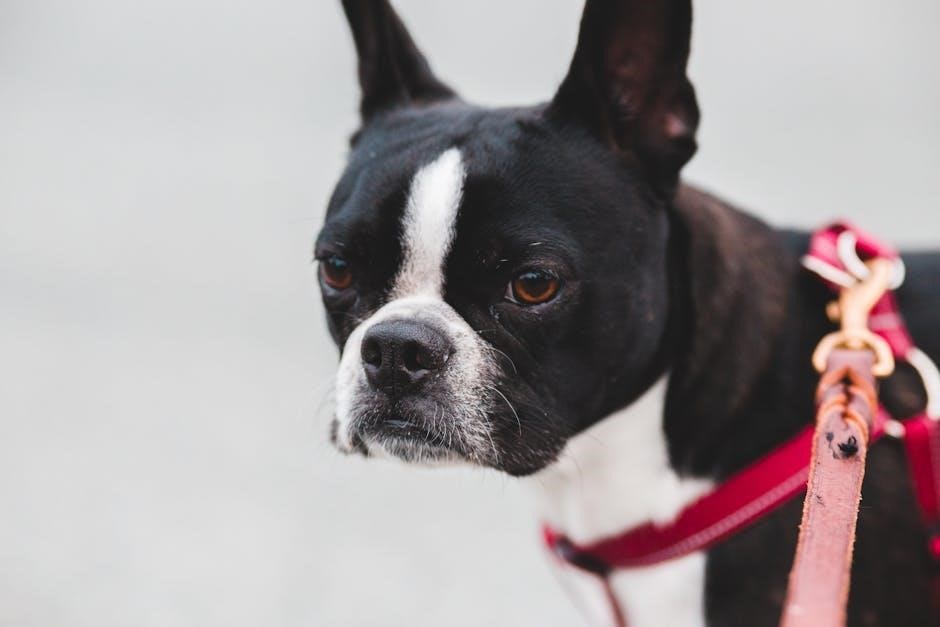A proper-fitting muzzle is essential for your dog’s comfort, safety, and effectiveness. This guide helps you understand muzzle sizing, ensuring a snug yet comfortable fit for various breeds, ages, and weights, while addressing key factors like snout length, circumference, and jaw structure to make informed choices for your dog’s needs.
Understanding the Importance of Proper Muzzle Fit
A proper muzzle fit is crucial for your dog’s comfort, safety, and the effectiveness of the muzzle. An ill-fitting muzzle can cause discomfort, restrict breathing, or even lead to injury. A muzzle that is too tight may impede panting and drinking, while one that is too loose may not serve its intended purpose. Ensuring a snug, comfortable fit is essential for your dog’s well-being and cooperation during use. Proper fit also prevents chafing or irritation, making muzzle training more successful and stress-free for both you and your dog.
Overview of Muzzle Size Charts
Muzzle size charts provide a structured approach to determining the right fit for your dog. These charts typically categorize muzzles into sizes ranging from Extra Small to Extra Large, based on measurements such as muzzle circumference, snout length, and width. By aligning your dog’s specific measurements with the chart, you can identify the optimal size for comfort and functionality. Factors like breed, jaw structure, and weight are also considered to ensure accuracy. Using a size chart helps prevent issues like tight fits or inadequate coverage, ensuring your dog’s muzzle is both effective and comfortable.

How to Measure Your Dog’s Muzzle
To measure your dog’s muzzle, start by wrapping a tape measure around the widest part of the snout, just below the eyes. Note the circumference and length from the tip of the nose to the base of the chin for an accurate fit.
Measuring Muzzle Circumference
To measure your dog’s muzzle circumference, wrap a flexible tape measure around the widest part of the snout, typically just below the eyes. Ensure the tape is snug but not overly tight, maintaining a level position. This measurement is crucial for determining the correct muzzle size, as it ensures proper fit and comfort. Record the circumference in inches or centimeters, then compare it to a muzzle size chart to find the best match. Accurate measurement is key to ensuring your dog can pant and move comfortably while wearing the muzzle.
Measuring Snout Length
To measure your dog’s snout length, start at the tip of the nose and extend the tape measure to the base of the snout, where it meets the face. Ensure the tape is level and not too tight. This measurement is vital for selecting the right muzzle size, as it ensures the muzzle allows proper breathing and comfort. Accuracy is key, so double-check the length before comparing it to a muzzle size chart. A well-fitted muzzle should neither restrict movement nor be overly loose, ensuring your dog can pant and move comfortably while wearing it.
Measuring Snout Width
Snout width is measured across the widest part of your dog’s snout, typically just below the eyes. Place the tape measure horizontally, ensuring it’s snug but not constricting. This measurement helps determine the correct muzzle width, allowing your dog to pant and eat comfortably. Accuracy is crucial to ensure the muzzle doesn’t press too tightly on the sides of the snout. Compare this width to the muzzle’s specifications to ensure a proper fit, preventing discomfort or restricted movement. A well-aligned width ensures the muzzle stays in place securely without causing irritation or impeding your dog’s natural behaviors.
Measuring Muzzle Girth
Muzzle girth is the circumference of your dog’s snout, measured around the widest part, typically just below the eyes. To measure accurately, wrap a flexible tape measure snugly around this area, ensuring it’s not too tight or loose. This measurement is critical for determining the correct muzzle size, as it ensures proper fit and comfort. A snug girth allows your dog to pant and move their jaw slightly while preventing the muzzle from slipping off. This step is essential for selecting a muzzle that balances safety, functionality, and your dog’s well-being.

Factors Influencing Muzzle Size
Breed, gender, age, weight, and jaw structure significantly impact muzzle size. These factors determine snout length, width, and circumference, guiding proper fit selection for comfort and functionality.
Breed-Specific Muzzle Sizes
Different dog breeds have unique muzzle shapes and sizes, requiring tailored fits. For example, German Shepherds and Labradors typically fit medium to large muzzles, while Pugs and Bulldogs need shorter, wider designs. Toy breeds like Chihuahuas require extra-small muzzles, while larger breeds such as Rottweilers or Pit Bulls need extra-large sizes. Breed-specific muzzle sizing ensures comfort and functionality, preventing discomfort or restricted breathing. Refer to breed-specific charts to match your dog’s muzzle dimensions accurately, ensuring a secure and comfortable fit for training, walking, or safety purposes.
Gender Differences in Muzzle Size
Male dogs often have larger muzzles than females, particularly in breeds where sexual dimorphism is pronounced. This difference is influenced by genetics and muscle development, with males generally having broader snouts. However, individual variation exists, and size isn’t solely determined by gender. While males may tend toward larger muzzles, accurate measurements are still crucial for a proper fit. Factors like breed, age, and weight also play significant roles. Always measure your dog’s muzzle circumference and length to ensure the best fit, regardless of gender, for optimal comfort and functionality.
Age and Muzzle Development
A dog’s muzzle size evolves significantly with age. Puppies typically have smaller, narrower muzzles that grow as they develop into adulthood. Regular measurements are essential, as muzzle size increases during growth. Proper fit ensures comfort and functionality, whether for training or safety purposes. As dogs mature, their muzzle shape and size stabilize, but senior dogs may experience changes due to weight fluctuations or health conditions, requiring adjustments to their muzzle fit.
Weight and Muzzle Size Correlation
A dog’s weight often correlates with muzzle size, as larger dogs typically have broader muzzles. However, this isn’t universal, as breeds vary in head shape and size. Monitoring weight changes is crucial, as gaining or losing weight can affect muzzle fit. A muzzle that’s too tight or loose can cause discomfort or inefficiency. Regularly measuring your dog’s muzzle circumference ensures the best fit, especially for dogs prone to weight fluctuations. This correlation helps in selecting the appropriate muzzle size for comfort and functionality.
Jaw Structure and Its Impact on Muzzle Fit
Jaw structure significantly influences muzzle fit, as different breeds have varying snout shapes and jaw alignments. Dogs with narrow or wide jaws require muzzles tailored to their specific anatomy. For example, breeds like German Shepherds or Pit Bulls often need muzzles designed for robust jaw structures. Proper measurement of both the muzzle’s circumference and length ensures a comfortable fit without restricting breathing or movement. Ignoring jaw structure can lead to discomfort or poor functionality. Always consider your dog’s jaw type when selecting a muzzle to ensure optimal comfort and safety.

Muzzle Size Chart
This chart categorizes muzzle sizes from Extra Small to Extra Large, providing precise measurements for circumference and length to ensure a perfect fit for various breeds and snout types.
Extra Small Muzzle Sizes
Extra Small muzzles are designed for tiny breeds, typically weighing under 10 lbs. They fit dogs like Chihuahuas, with a muzzle circumference of 10-11 inches and a snout length of 3-4 inches. These muzzles ensure comfort while allowing your dog to pant and drink. They are ideal for small dogs requiring gentle control or protection. Always choose a muzzle that fits snugly but not too tight, ensuring your dog’s comfort and safety. Proper sizing ensures effective use for training or public outings. Measure carefully to match your dog’s dimensions for the best fit.
Small Muzzle Sizes
Small muzzles are ideal for dogs weighing between 10-25 lbs, such as Cavalier King Charles Spaniels. These muzzles typically have a circumference of 12-13 inches and a snout length of 4-5 inches. They are designed to provide a secure fit while allowing your dog to pant and drink comfortably. Proper sizing is crucial to ensure your dog’s comfort and safety. Measure your dog’s snout carefully to match the size chart, ensuring the muzzle isn’t too tight or restrictive. This size is perfect for breeds that require a balance between control and comfort, making it versatile for training or public outings.
Medium Muzzle Sizes
Medium muzzles are designed for dogs weighing between 25-50 lbs, such as Labrador Retrievers. They typically feature a circumference of 14-15 inches and a snout length of 5-6 inches. These muzzles provide a balance between comfort and control, making them suitable for training, walking, and social interactions. Proper sizing ensures your dog can breathe and pant easily while wearing the muzzle. Measure your dog’s snout carefully to match the size chart, ensuring a snug yet comfortable fit. This size is ideal for active breeds that require a muzzle for safety and training purposes without compromising their well-being.
Large Muzzle Sizes
Large muzzle sizes are designed for dogs weighing between 50-70 lbs, such as German Shepherds or Rottweilers. These muzzles typically have a circumference of 16-17 inches and a snout length of 6-7 inches. They are ideal for larger breeds with broader snouts, ensuring comfort and control during training or public outings. Proper fitting is crucial to allow panting and drinking while preventing unwanted behaviors. Measure carefully to match your dog’s dimensions to the size chart, ensuring a secure yet non-restrictive fit. This size is perfect for active, powerful breeds requiring a durable muzzle for safety and functionality.
Extra Large Muzzle Sizes
Extra large muzzle sizes cater to larger breeds over 70 lbs, such as Mastiffs or Great Danes. These muzzles typically measure 17-18 inches in circumference and 7-8 inches in snout length. Designed for powerful dogs, they provide a secure fit while allowing for panting and drinking. Proper measurement is crucial to ensure comfort and functionality. These muzzles are ideal for dogs requiring maximum control during training or public walks, offering durability and safety without restricting natural breathing or movement. Always consult size charts to match your dog’s measurements for the best fit.

Choosing the Right Muzzle Type
Selecting the right muzzle type depends on your dog’s needs, breed, and purpose; Basket muzzles offer durability and breathability, while leather or nylon muzzles provide lightweight comfort for training and specific tasks.
Basket Muzzles
Basket muzzles are a popular choice due to their durability and breathability. Made from materials like plastic or metal, they allow dogs to pant and drink comfortably. Ideal for training, these muzzles provide a snug fit while preventing biting or chewing. Their sturdy design makes them suitable for high-energy breeds; Proper sizing is crucial to ensure comfort and functionality. Introducing a basket muzzle gradually can help your dog adapt positively. They are also easy to clean and maintain, making them a practical option for everyday use or specific training purposes.
Leather Muzzles
Leather muzzles are a durable and stylish option, offering a snug, comfortable fit for dogs. Made from high-quality leather, they are often used for training and controlling unwanted behaviors. Proper sizing is essential to ensure your dog can pant and move comfortably. Measure your dog’s snout circumference and length to find the right fit. Leather muzzles are easy to clean and maintain, making them a practical choice for long-term use. They are particularly suitable for breeds with specific jaw structures, providing both safety and style. Introducing the muzzle gradually can help your dog adapt to wearing it comfortably.
Nylon Muzzles
Nylon muzzles are lightweight, durable, and breathable, making them a popular choice for dogs. They are often used for training and short-term use due to their soft yet sturdy design. Nylon muzzles typically feature adjustable straps for a secure fit and may include a mesh panel for ventilation. Proper sizing is crucial to ensure your dog can pant and move comfortably. They are easy to clean and maintain, offering a practical solution for everyday use. Nylon muzzles are ideal for smaller breeds or dogs that require a gentle yet effective restraint option. Introduce them gradually to help your dog adapt smoothly.
Training Muzzles
Training muzzles are specifically designed to aid in behavior modification and obedience training. They allow dogs to pant, drink, and take treats, making them ideal for extended training sessions. These muzzles are typically made from lightweight, breathable materials like nylon or rubber, ensuring comfort while restricting biting or nipping. Proper sizing is crucial to ensure your dog can move comfortably without the muzzle causing discomfort. Training muzzles are a great tool for addressing aggression or resource guarding. Introduce the muzzle gradually, using positive reinforcement to help your dog associate it with positive experiences. This approach ensures a stress-free and effective training process.
Specific-Purpose Muzzles
Specific-purpose muzzles are tailored for unique situations, such as police K-9 operations, grooming, or high-energy activities. These muzzles are designed with durability and functionality in mind, often featuring reinforced materials or adjustable straps for a secure fit. Some models allow for easy panting and drinking, while others prioritize protection in high-stress environments. Sizing for these muzzles may vary based on the intended use, with measurements focusing on snout length, width, and girth to ensure optimal performance. Always consult the manufacturer’s sizing chart to match your dog’s measurements with the correct muzzle type for its specific purpose.

Training Your Dog to Wear a Muzzle
Introduce the muzzle gradually using positive reinforcement. Ensure a proper fit for comfort and effective training, helping your dog associate it with enjoyable experiences easily.
Introducing a muzzle to your dog requires patience and consistency. Start by creating a positive association, allowing your dog to explore the muzzle at their own pace. Reward curiosity with treats and praise to build trust. Gradually increase exposure, ensuring your dog feels comfortable with the muzzle’s presence and fit. Proper training ensures your dog accepts the muzzle calmly, making it easier for both of you during walks, vet visits, or training sessions. A well-trained dog will associate the muzzle with positive experiences, fostering a stress-free environment for everyone involved.
Positive Reinforcement Techniques
Positive reinforcement is a powerful method for muzzle training. Begin by offering treats and praise when your dog shows curiosity or calmness around the muzzle. Place the muzzle near your dog with rewards, then gradually introduce it onto their snout for short periods. Reward your dog for remaining relaxed. Over time, increase the duration the muzzle is worn, always ending on a positive note. This approach builds trust and reduces anxiety, ensuring your dog associates the muzzle with pleasant experiences. Consistency and patience are key to a smooth and stress-free training process.
Gradual Desensitization
Gradual desensitization helps your dog become comfortable with the muzzle without stress. Start by letting your dog see and sniff the muzzle while offering treats. Next, gently touch the muzzle to their snout or cheek for short moments, rewarding calm behavior. Progress by placing the muzzle on their nose for brief periods, ensuring it’s loose enough to allow panting and comfort. Slowly increase the time as your dog becomes accustomed. Avoid rushing, as this can create negative associations. Patience is key to helping your dog accept the muzzle as a normal, non-threatening object.
Practicing Muzzle Wearing
Once your dog is comfortable with the muzzle’s presence, it’s time to practice wearing it. Start with short sessions, allowing your dog to become accustomed to the feel and restriction. Ensure the muzzle fits properly, enabling your dog to pant, drink, and receive treats. Reward calm behavior with praise and rewards to reinforce positive associations. Gradually increase the duration as your dog grows more confident. Always supervise to ensure safety and comfort, adjusting the fit if necessary. Consistent practice helps your dog accept the muzzle as a normal part of their routine, making future use stress-free and effective.

Muzzle Maintenance and Care
Regular cleaning and proper storage are crucial for maintaining your dog’s muzzle. Clean with mild soap, dry thoroughly to prevent moisture buildup, and inspect for wear. Store in a cool, dry place to maintain shape and longevity, ensuring optimal comfort and safety for your dog.
Cleaning and Sanitizing the Muzzle
Regular cleaning and sanitizing of your dog’s muzzle are essential to maintain hygiene and prevent odor buildup. Start by removing any adjustable straps and washing the muzzle with mild soap and warm water. Avoid using harsh chemicals, as they may damage the material or irritate your dog’s skin. Rinse thoroughly and allow the muzzle to air dry completely. For leather muzzles, use a gentle leather cleaner and conditioner to preserve the material. Nylon and plastic muzzles can be sanitized with a pet-safe disinfectant. Regular cleaning ensures your dog’s muzzle remains comfortable, safe, and free from bacteria.
Storing the Muzzle Properly
Proper storage of your dog’s muzzle is essential to maintain its shape, prevent damage, and ensure it remains clean. Store the muzzle in a cool, dry place, away from direct sunlight and humidity. For nylon or plastic muzzles, wiping them clean before storage helps prevent dirt buildup. Leather muzzles should be conditioned occasionally to avoid cracking. Avoid folding or creasing the muzzle, as this can weaken the material. Use a protective bag or box to store it, keeping it away from other gear that might cause abrasion. Proper storage ensures your dog’s muzzle stays in great condition for future use.
Inspecting for Wear and Tear
Regularly inspecting your dog’s muzzle for wear and tear is crucial to ensure it remains functional and comfortable. Check for signs of fraying, cracks, or broken straps. For leather muzzles, look for cracks or worn-out stitching. Nylon muzzles should be examined for tears or holes. Metal basket muzzles may show signs of rust or bent wires. If you notice any damage, replace the muzzle immediately to prevent discomfort or injury to your dog. Inspections should be done after each use and especially after cleaning to maintain your dog’s safety and the muzzle’s durability over time.

Troubleshooting Common Issues
Common issues with muzzles include improper fit, discomfort, or resistance from dogs. Addressing these promptly ensures comfort and safety, maintaining a positive experience for your dog.
Adjusting for a Perfect Fit
Ensuring your dog’s muzzle fits perfectly is crucial for comfort and functionality. Start by measuring the snout circumference and length accurately, then compare to the size chart. If the muzzle feels too tight, consider a larger size. For a loose fit, opt for a smaller size or adjustable straps. Proper fit allows panting, drinking, and minimal movement without causing irritation. Regularly check the fit, especially for growing dogs, to maintain comfort and safety. A well-adjusted muzzle ensures your dog’s well-being and effectiveness in various situations, making it a reliable tool for training or everyday use.
Resolving Discomfort or Irritation
If your dog shows signs of discomfort or irritation from the muzzle, ensure proper fit by measuring accurately and consulting the size chart. A too-tight muzzle can cause chafing or pressure points, so consider a larger size. Check for areas where the muzzle may rub and adjust straps to alleviate pressure. Introduce the muzzle gradually to allow your dog to acclimate. If irritation persists, try a muzzle with padding or a different material. Always monitor your dog’s behavior and adjust as needed to ensure comfort and prevent stress.
Addressing Resistance to Wearing
If your dog resists wearing a muzzle, start with positive reinforcement. Introduce the muzzle gradually, allowing your dog to become familiar with its sight, smell, and feel. Reward calm behavior with treats and praise. Ensure the muzzle is well-fitted to avoid discomfort. Make the muzzle a routine part of activities your dog enjoys, such as walks or playtime, to reduce anxiety. Consistency and patience are key; never force the muzzle, as this can create lasting resistance.
Proper muzzle fit ensures safety, comfort, and effectiveness. Regularly check fit as your dog grows. Positive reinforcement aids in muzzle training, making it a stress-free experience for your pet.
Measuring your dog’s muzzle circumference, snout length, and width ensures a proper fit. Regular measurements are crucial as dogs grow. Breed, gender, age, and weight influence muzzle size. Proper fit prevents discomfort and ensures safety. Positive reinforcement aids in muzzle training, helping dogs accept wearing muzzles comfortably. Choosing the right muzzle type depends on your dog’s needs, such as training, walks, or specific tasks. A well-fitted muzzle promotes safety, comfort, and effectiveness, ensuring your dog’s well-being and ease of use for owners.
Final Tips for Muzzle Usage
Introduce the muzzle gradually, using positive reinforcement to ensure your dog accepts it comfortably. Always ensure proper fit to prevent discomfort or restriction. Choose a muzzle type suited to your dog’s needs, such as training or walking. Allow your dog to pant and drink freely while muzzled for their well-being. Regularly inspect the muzzle for wear and tear, and adjust as needed for growth or weight changes. Monitor your dog’s behavior to ensure the muzzle remains effective and comfortable, promoting safety and ease of use for both you and your pet.
